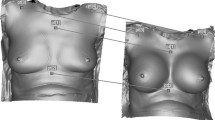Abstract
Background
Three-dimensional (3D) terrestrial laser scanning (TLS) is a valuable method for measuring shapes of objects and for obtaining quantitative measurements. These qualities of the 3D laser scanner have proved to be useful in reconstructive breast surgery. This study investigated various 3D parameters to obtain an optimal objective visualization of the breast after cosmetic augmentation mammaplasty.
Methods
The objects are represented in a point cloud, which comprises millions of x, y, and z coordinates representing a virtual image. The quantification of 3D points shows changes in height (z coordinate) at any chosen point on the augmented breast (x and y coordinates). To give visual feedback on the change in dimensions, a color elevation scheme was applied on the reconstructed surface of the breast. As a quantifying description, a sagittal B-spline was chosen in a plane through the nipple to obtain the breast shape via the lateral profile.
Results
Pre- and postoperative clear images were obtained. The color elevation model showed an increased projection and upper pole fullness after augmentation. The B-spline showed the gain in projection in a sagittal plane through the nipple.
Conclusions
Three-dimensional TLS is capable of objectifying changes in shape after augmentation mammaplasty. This imaging technique represents superior visualization of the breast shape and can serve as a valuable tool to determine the changing dimensions of the breasts after augmentation mammaplasty.





Similar content being viewed by others
References
Becker S, Haala N (2007) Combined feature extraction for facade reconstruction. ISPRS workshop on Laser Scanning and SilviLaser 2007, Espoo, Finland
Brown TP, Ringrose C, Hyland RE, Cole AA, Brotherston TM (1999) A method of assessing female breast morphometry and its clinical application. Br J Plast Surg 52:355–359
Bucksch A, Lindenbergh R (2007) A skeletonization method for point cloud processing ISPRS. J Photogramm Remot Sens (submitted)
Bucksch A, Lindenbergh R, Ree J (2007) Influence of the intensity remission on the scan quality. In: Presented at the symposium on the error budget of terrestrial laserscanning, GeoSiberia, Novosibirsk, Russia
Bush K, Antonyshyn O (1996) Three-dimensional facial anthropometry using a laser surface scanner: validation of the technique. Plast Reconstr Surg 98:226–235
Edsander-Nord A, Wickman M, Jurell G (1996) Measurement of breast volume with thermoplastic casts. Scand J Plast Reconstr Surg Hand Surg 30:129–132
Farkas LG, Bryson W, Klotz J (1980) Is photogrammetry of the face reliable? Plast Reconstr Surg 66:346–355
Ferrario VF, Sforza C, Poggio CE, Tartaglia G (1994) Distance from symmetry: a three-dimensional evaluation of facial asymmetry. J Oral Maxillofac Surg 52:1126–1132
Galdino GM, Nahabedian M, Chiaramonte M, Geng JZ, Klatsky S, Manson P (2002) Clinical applications of three-dimensional photography in breast surgery. Plast Reconstr Surg 110:58–70
Gorte B (2007) Skeletonization of laser-scanned trees in the 3D Raster domain. Presented on a symposium, 3DGeoInfo2006, Malaysia
Isogai N, Sai K, Kamiishi H, Watatani M, Inui H, Shiozaki H (2006) Quantitative analysis of the reconstructed breast using a 3-dimensional laser light scanner. Ann Plast Surg 56:237–242
Kaneko T (1993) A system for three-dimensional shape measurement and its application in microtia ear reconstruction. Keio J Med 42:22–40
Kouchi M, Mochimaru M, Tsuzuki K, Yokoi T (1996) Random errors in anthropometry. J Hum Ergol (Tokyo) 25:155–166
Kovacs L, Zimmermann A, Papadopulos NA, Biemer E (2004) Factors determining shape and symmetry in immediate breast reconstruction. Ann Plast Surg 53:192–194
Kovacs L, Yassouridis A, Zimmermann A, Brockmann G, Wohnl A, Blaschke M, Eder M, Schwenzer-Zimmerer K, Rosenberg R, Papadopulos NA, Biemer E (2006) Optimization of 3-dimensional imaging of the breast region with 3-dimensional laser scanners. Ann Plast Surg 56:229–236
LePage MA, Kazerooni EA, Helvie MA, Wilkins EG (1999) Breast reconstruction with TRAM flaps: normal and abnormal appearances at CT. Radiographics 19:1593–1603
Loughry CW, Sheffer DB, Price TE Jr, Lackney MJ, Bartfai RG, Morek WM (1987) Breast volume measurement of 248 women using biostereometric analysis. Plast Reconstr Surg 80:553–558
Loughry CW, Sheffer DB, Price TE, Einsporn RL, Bartfai RG, Morek WM, Meli NM (1989) Breast volume measurement of 598 women using biostereometric analysis. Ann Plast Surg 22:380–385
Mineyev M, Kramer D, Kaufman L, Carlson J, Frankel S (1995) Measurement of breast implant volume with magnetic resonance imaging. Ann Plast Surg 34:348–351
Nipshagen MD, Beekman WH, Esme DL, de Becker J (2007) Anatomically shaped breast prosthesis in vivo: a change of dimension? Aesth Plast Surg 31(5):540–543
O’Grady KF, Antonyshyn OM (1999) Facial asymmetry: three-dimensional analysis using laser surface scanning. Plast Reconstr Surg 104:928–937
Prautzsch H, Boehm W, Paluszny M (2002) Bezier and B-spline techniques. Mathematics and visualization, XIV. ISBN 978-3-540-43761-1
Rabbani T (2007) Automatic reconstruction of industrial installations using point clouds and images. PhD thesis, Delft University of Technology
Rohrich RJ (2000) The increasing popularity of cosmetic surgery procedures: a look at statistics in plastic surgery. Plast Reconstr Surg 106:1363–1365
Tebbetts JB (2006) Dual-plane breast augmentation: optimizing implant–soft tissue relationships in a wide range of breast types. Plast Reconstr Surg 118:81S–98S
Van Zele D, Heymans O (2004) Breast implants: a review. Acta Chir Belg 104:158–165
Westreich M (1997) Anthropomorphic breast measurement: protocol and results in 50 women with aesthetically perfect breasts and clinical application. Plast Reconstr Surg 100:468–479
Author information
Authors and Affiliations
Corresponding author
Rights and permissions
About this article
Cite this article
Esme, D.L., Bucksch, A. & Beekman, W.H. Three-Dimensional Laser Imaging as a Valuable Tool for Specifying Changes in Breast Shape After Augmentation Mammaplasty. Aesth Plast Surg 33, 191–195 (2009). https://doi.org/10.1007/s00266-008-9259-y
Received:
Accepted:
Published:
Issue Date:
DOI: https://doi.org/10.1007/s00266-008-9259-y




